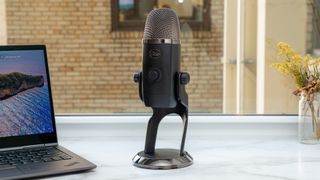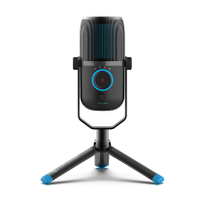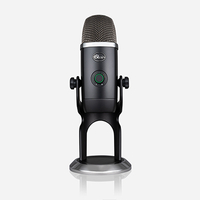The best streaming microphones are a great option for those looking to get into live streaming. Whether you're just streaming for fun or looking to do it professionally and need your live stream to stand out from the competition, a great microphone is a great investment. There's nothing worse than annoyingly poor sound quality.
Luckily, you can't go wrong with any of the best streaming mics we've tested, so feel free to pick the mic with the features that best suit your needs. Whether you are a professional YouTuber or just hopping on Twitch for fun any of these picks are a great option.
Don't forget that streaming mics come in a whole range of visual styles too. Some are designed to look great on camera, while others have more plain looks but still produce excellent sound quality. And just because a mic looks flashy doesn't mean it's the best-sounding mic — our top picks often don't look the flashiest. So read on to discover our pick of the best streaming microphones we've tested.
Top 3 best streaming microphones
Why you can trust Tom's Guide
The best streaming microphones to buy right now


What else but the perennially beloved Blue Yeti? While Logitech now has the Yet under the Logitech for Creators brand rather than the Blue brand, it's still one of the best microphones out there for any purpose. Combining class-leading performance with a simple, easy-to-use design, the Yeti doesn’t seem anywhere close to showing its age. It’s not too expensive either, so can serve first-time microphone owners as well as it can seasoned streamers.
In addition to the cardioid mode, which is what you should use when you’re only recording yourself, the Blue Yeti also offers bidirectional, omnidirectional and stereo recording patterns. That gives it a lot of extra flexibility if you live stream podcast recordings or interviews, rather than games or commentary.
Read our full Blue Yeti review.


When we say the JLab Talk is a cheaper Blue Yeti, we don’t mean that as a slight. Yes, the Talk is also a fairly compact USB microphone with the same four recording patterns as the Yeti, but those are good things. And its bass-rich but detailed recording quality can definitely give that touch of professionalism to your stream.
The Talk is also impressively practical, with a light-up gain indicator, a 3.5mm jack for mic monitoring and an adjustable tripod stand. Even the best streaming microphones can be made better by adding a boom arm, but this little tripod can at least provide some high adjustment.
Read our full JLab Talk review.

If you’ve got a little extra cash, it can be worth stretching to the Blue Yeti X — now called the Logitech for Creators X. It would make you sound drastically better than the standard Yeti, but it does at least improve on the control scheme. For instance, you can check your volume levels at a glance using the LED display, and Blue has wisely moved the gain switch to the front, so it’s more easily accessible in a pinch.
Despite the extra bells and whistles, the Yeti X never forgets about the simplicity that helped make the Yeti such an enduring microphone champion. It’s still plug-and-play with a PC-friendly USB connection; a complicated studio microphone this is not.
Read our full Blue Yeti X review.

The Wave: 3’s party trick is how it works together with the Elgato Stream Deck. Set up both together and you can control your mic input volume, mix audio between the Wave: 3 and other sources or toggle monitoring all at the push of a button. When you’re trying to focus on hosting an entertaining stream, the appeal of such a control scheme is clear.
Even without the Stream Deck, though, there’s plenty about the Wave: 3 that makes it a fine microphone. Recording quality is high, with particular resistance to pops and background noise, and you can always use the onboard controls to make adjustments as well.
Read our full Elgato Wave: 3 review.

If you’re going to appear on-camera for a stream, you can add some visual flair from an unlikely source: your microphone. The HyperX QuadCast S is covered in fully customizable RGB lighting, which makes it an especially good match for other light-up gaming peripherals and PCs.
Luckily, the QuadCast S isn’t just for showing off. Its cardioid-pattern recording sound is clean and clear enough for serious streamers, and its built-in shock mount helps prevent awkward bumping sounds should you need to reposition it. The QuadCast S is more expensive than the RGB-less QuadCast, but in terms of illuminated options, it’s one of our favorite mics.
Read our full HyperX QuadCast S review.

Not unlike the JLab Talk, Movo’s UM700 seeks to undercut the Blue Yeti. On a purely mathematical basis, it succeeds — the UM700 is significantly cheaper — and that’s without sacrificing much in the way of build quality. You get the full set of cardioid, bidirectional, omnidirectional and stereo recording modes as well.
Sound quality isn’t quite on the Yeti’s level, so stick with the latter if you want your stream to sound as professional as possible. But the UM700 still offers more-than-adequate clarity for casual or amateur streams, so it’s worth considering if you just want something affordable.
Read our full Movo UM700 review.

A Blue Yeti, but smaller? It’s a great idea, and the Blue Yeti Nano is a great streaming mic. As per usual for the Blue brand, it’s incredibly easy to set up and use, and its tight dimensions are both more considerate of your desk space and better for packing up and traveling.
The Nano is also cheaper than the standard Blue Yeti, though the JLab Talk does sound better, should you be bargain-hunting. The Blue Yeti Nano also cuts the supported recording patterns down to just cardioid and omnidirectional, though remember that you only need cardioid if you’re just recording yourself.
One wrinkle with the Nano though —currently, the branding is a bit confusing. With Logitech sunsetting the Blue brand for its mics and switching them to the new Logitech for Creators brand, you may come across both brand names when searching for the pint-sized microphone. Rest assured that whichever name it is, it's still the same great mic.
Read our full Blue Yeti Nano review.

The EPOS B20 is another mic that bills itself as a streaming aid specifically. But whereas the Elgato Wave: 3 fulfills its potential through added hardware, the B20 is at its best when paired with software: the EPOS Gaming Suite. This adds access to a host of audio settings that you can’t control from the microphone alone.
We also love the B20’s sleek aesthetic and crisp sound quality. If it were cheaper it would give the Blue Yeti a real run for its money, but even at current pricing, it could be worth splurging for if you want to fine-tune your stream audio through the companion software.
Read our full EPOS B20 review.
How to choose the best streaming microphone for you
Your foremost concern when choosing any desktop-style microphone should be sound quality. A lot of potential issues, like dull looks or poorly-adjustable stands, can be ignored or compensated for — but if a streaming microphone sounds weak or lacking in detail, your entire stream suffers. Be sure to read our full reviews linked above, where we’ve described how each mic sounds.
Many microphones offer different directional recording patterns: cardioid, bidirectional, omnidirectional or stereo. Bidirectional or omnidirectional modes are very useful for recording multiple speakers with a single mic, but if you’re just running a gaming stream — or any kind of stream where you’re the only one being recorded — then cardioid is all you need. This only records the space directly in front of the mic so is perfect for minimizing background noise.
For pricing, we think you don't need to spend more than $200, and probably shouldn't spend less than about $50. Zoom calls are one thing but for a quality stream, going too cheap will likely mean you won't get sufficient recording capability in return.
We’ve also stuck with USB microphones, as these are by far the easiest to get set up on a PC or laptop. You can get some consumer-friendly mics that use a professional-grade XLR connection, but these require additional (and expensive) hardware to set up. For streaming, as opposed to podcasting, that extra budget is better spent on your computer hardware.
How we test streaming microphones
When testing any kind of microphone, we’ll use a combination of recordings and live, person-to-person feedback to find out how each mic sounds. For streaming microphones, how it sounds in what is essential VoIP (Voice over IP) conditions is particularly important, as local recordings alone might not capture how a microphone sounds when the sound is transmitted online.
Besides testing a microphone itself, we’ll also try out any recommended or bundled software, to see if it’s actually worth using in conjunction with the hardware. Ideally, a mic should work well by itself, but sometimes these apps do provide useful extras that could make your stream sound just that little bit better.
Once testing is completed, we rate the best gaming microphones based on our five-point system (1 = worst, 5 = best). Products that hit nearly every mark are awarded an Editor's Choice badge.
Next: Check out the best gaming microphones or find a versatile design with the best USB microphones for better voice and video calls. Plus, if you're hosting more than streams then check out the best podcasting microphones overall, as well as the best headphones with a mic for voice and video calls.





